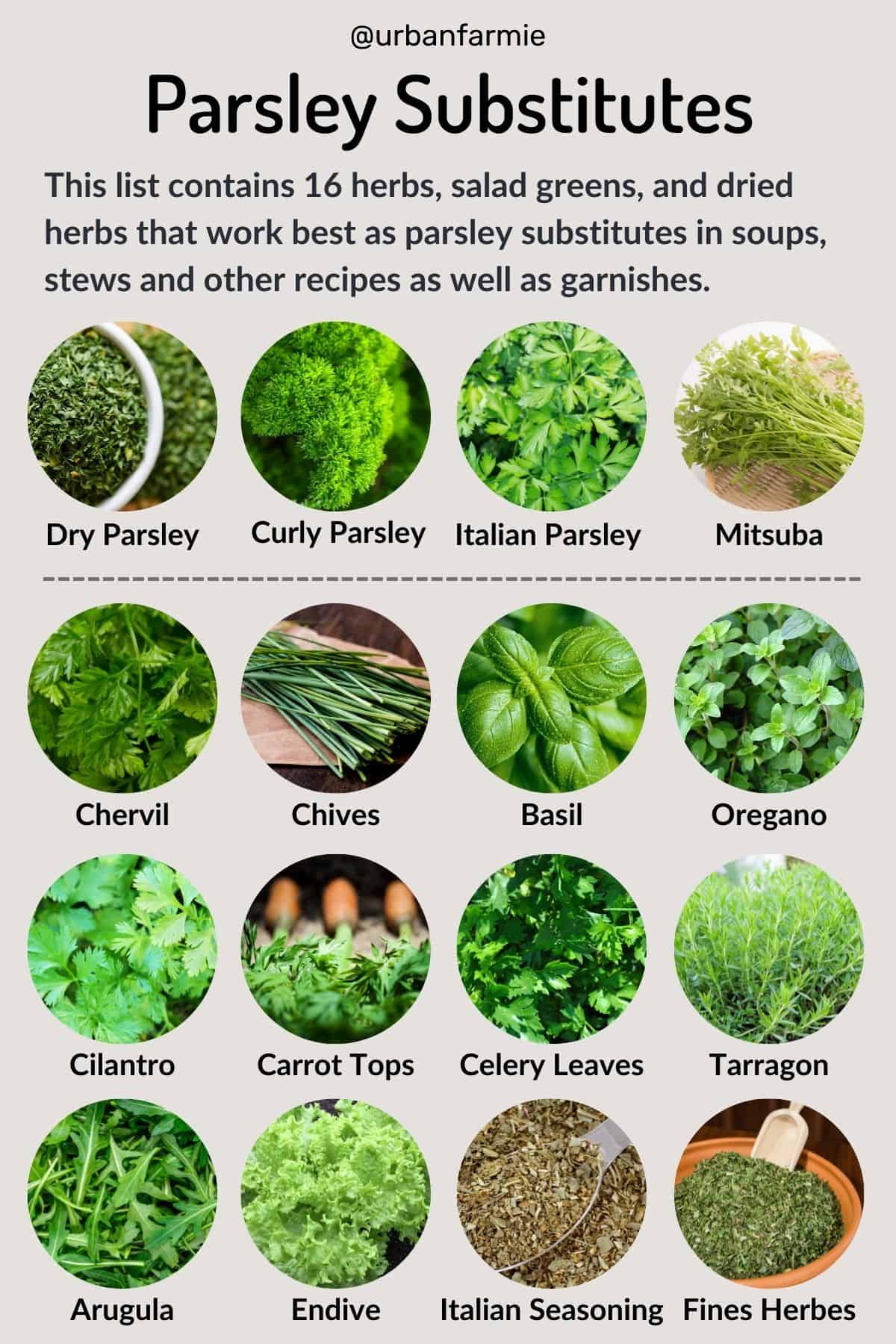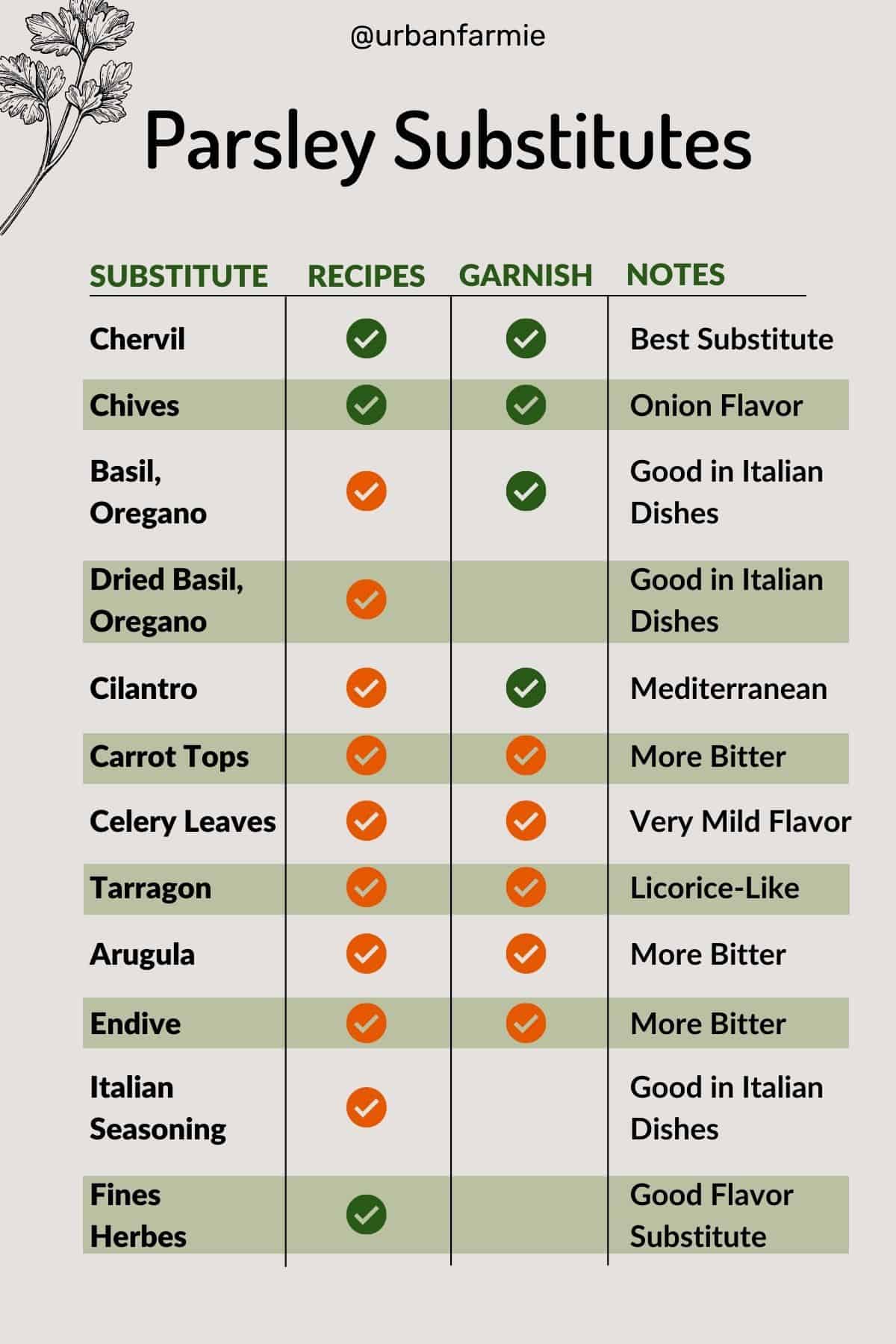Fresh parsley is synonymous with herby, summer notes. There are two types of parsley - flat leaf and curly. Both impart a peppery taste and herbaceous Mediterranean flavor to dishes. But like basil, parsley can be a bit hard to substitute (especially in recipes like tabbouleh). But don't despair for the best parsley substitute: read on for sixteen great options and tips on when to use which option!

Different Types of Parsley
Most recipes that call for parsley don't actually distinguish between the types of parsley. There are four varieties of parsley, though two are more common than others. Before we jump into substitutes, it's important to understand the differences in flavors among different types of parsley.
- Flat-leaf or Italian Parsley is the most common type of parsley (the type of parsley to use if the recipe doesn't specify which type to use). It has a delicious, distinct, strong herbaceous and peppery flavor.
- Curly-leaf parsley is most commonly used as a garnish, with a mild flavor profile. It's less peppery than flat-leaf parsley.
- Japanese parsley (also called Mitsuba or Japanese honewort) actually belongs to the carrot family. It is not as common here in the US, but is commonly used in Japanese cuisine (as well as some Chinese and Korean dishes). It's mostly used as a garnish in soups or rice bowls.
- Hamburg parsley (also called root parsley!) is, as you guessed from it's name, famous for its roots. However, the taste profile of the leaves are very different from regular parsley so they can’t be used as a substitute for flat-leaf parsley.
Italian Parsley vs. Parsley
Flat-leaf parsley (also called Italian parsley) has a stronger flavor. Curly leaf parsley has a milder flavor and also used as garnish. If a recipe calls for one of these, you can usually substitute the other. Both Italian and curly parsley can be used in soups, stews and other recipes, but flat leaf parsley is stronger and can be cooked longer without wilting compared to curly parsley (so can be added earlier in the cooking process).
Sixteen Best Parsley Substitutes
It can be quite hard to substitute parsley in a ranch dressing or a Green Goddess dressing. But I've listed sixteen substitutes in order of suitability. There's also a handy infographic at the end of this section!
Substitute Other Types of Parsley
In a pinch, if a recipe calls for one type of parsley, you can substitute it with another type of parsley. The best part about this is that you can do so in a 1:1 ratio, without compromising on the flavor profile.
- Fresh vs. dried parsley: Fresh parsley has stronger flavors than dried parsley (which is milder, more subdued). If you're drying the parsley yourself, one tip here is to not crush it until it's ready for use. Crushing the dried herbs releases aromatic oils which enhances the flavor profile. Fresh parsley is better for garnishing, and for cooking with stronger flavors, but dried parsley has a longer shelf life and will not wilt or go to waste as easily.
- Flat-leaf parsley works great in place of curly leaf or Japanese parsley very easily. In fact, a lot of chefs actually prefer to use Italian parsley because of it's bold flavors. As a result, watch out if you're adding flat-leaf parsley to a more muted dish.
- Curly-leaf parsley has a much milder flavor profile. So you can also easily use it to substitute other types of parsley, especially as a garnish.
- Japanese parsley works great as a substitute for parsley in Asian dishes. It can also work in Mediterranean soups and stews, but I would suggest adding a bit, tasting and then adjusting if you're using it in the recipe itself. It works great as a regular garnish.
Non Parsley Substitutes
- Chervil (also called French parsley!) is a versatile herb and the best substitute to parsley in taste, texture, and appearance. You can use fresh or dried chervil as a replacement both in recipes and as a garnish, due to their bright green color. So if you're looking for a parsley replacement with a similar look, chervil is your best bet. However, chervil leaves are a lot milder than parsley so use 1.5x the amount of parsley required.
- Chives are yet another good fresh parsley substitute since they look alike and have a mild flavor that could work well in a number of dishes. However, they do taste more like allium (i.e., garlic and onion) so add slowly and taste to adjust. Dried chives also work well in recipes.
- Oregano and basil (or these basil substitutes) are an excellent substitute for parsley if you're looking to replace fresh parsley in an Italian dish. These popular herbs are members of the mint family, easily available in grocery stores and can be grown easily at home as well. But this substitution only really works in Italian dishes.
- Dried oregano or basil are good substitutes for dried parsley as well. Both have bolder flavors than parsley, so you might need to adjust the amount down depending on the recipe.
- Cilantro is a great substitute for parsley, both as a garnish and in more Mediterranean or Middle Eastern dishes (e.g., shakshuka). It's also likely the easiest herb to find in a grocery store. I've also found that cilantro is the only herb that can come close to replacing parsley in tabbouleh. That said, if you experience a soapy taste with cilantro leaves, I'd skip this one and move to the other options on this list.
- Carrot greens are a decent replacement in place of parsley, say as a salad green. They have a bitter finish and a similar mild taste, so they're great to use where you need a more subtle flavor. Chop really finely to substitute as parsley in a soup or stew.
- Celery leaves, like carrot tops, have an extremely mild flavor and look similar to parsley. So they can make a decent substitute for parsley as well. Chop really finely to substitute as parsley in a soup or stew.
- Tarragon is the last aromatic herb on this list. Tarragon has a licorice-like strong flavor and a peppery taste, so it's a somewhat similar flavor profile. However, it's also bright green and similar-looking to parsley, so makes for a great garnish substitute.
- Arugula or rocket is a salad green with a peppery and bitter flavor. Like carrot tops and celery greens, you need to chop these finely to use in soups and stews and could make a passable garnish replacement. However, given the inherent bitterness, use only a very small amount.
- Curly endive, another salad green like arugula, looks very similar to curly parsley so it's a good substitute for garnishing. It can also be used in soups and stews, but like arugula, needs to be added in small doses to avoid the bitterness from overpowering the dish.
- Italian seasoning makes for a great parsley substitute, especially in Italian dishes. This is a pre-mixed blend of ground herbs including basil, oregano, rosemary, thyme, and sage. So it can serve to lift up Italian dishes that require a Mediterranean flavor profile. This will have a different taste profile, but make good flavor substitutes nonetheless.
- Fines herbes is a good replacement for parsley in French cuisine since it's a pre-mixed seasoning that already contains parsley (in addition to chives, tarragon, and chervil). So you'll get parsley flavor in addition to other complementary flavors. Use small amounts of dried herb to flavor the dish, and taste to adjust.

FAQs and Top Tips
Fresh parsley has much stronger flavors than dried parsley, so you can use smaller amounts of the fresh herb compared to the dried one. Typically, if a recipe calls for dried parsley, and you want to use fresh parsley, use half the amount required.
Technically, yes. However, dried parsley has a much more muted, subtle flavor, so you might need to double (or triple) the amount needed, but still fall short of the fresh, herby notes you're looking for. So I recommend one of the fresh herbs listed above instead. If you do go this route, use one teaspoon of dried parsley for one tablespoon of fresh parsley.
Dried basil is typically the best match here. I use a 1:1 substitute (i.e., if a recipe calls for a tablespoon of dried parsley, use a tablespoon of dried basil instead). If you want to make dried basil, check out my detailed guide on how you can dry fresh basil.
What are your favorite substitutes for parsley? Let us know in the comments if we've missed any!










Comments
No Comments